In a site called “Hold this Thought” Tom Livingston (Between Silence and Light) quotes architect Louis Kahn:
Architect Louis Kahn’s writings about daylight resonate with me. Here he talks about the nature of a room and its natural light:
“The room is not only the beginning of architecture: it is an extension of self. If you think about it, you realize that you don’t say the same thing in a small room that you say in a large room. If I were to speak in a great hall, I would have to pick one person who smiles at me in order to be able to speak at all.
…
Also marvelous in a room is the light that comes through the windows of that room and that belongs to the room. The sun does not realize how wonderful it is until after a room is made. A man’s creation, the making of a room, is nothing short of a miracle. Just think, that a man can claim a slice of the sun.”
http://www.holdthisthought.org/blog/index.cfm/2008/12/23/Between-Silence-and-Light-Tom-Livingston
I’m rather addicted to painting plein air, but the weather in western Oregon is more like eastern Kansas (ie snow, ice, slush, ugh!) right now. So I’ve been painting from my windows, which frame various neighborhood views and foliage. But the Kahn quote also gets me to thinking about the nature of rooms, which I haven’t painted.
This is the unprepossessing set-up in my kitchen. The reason for painting in the kitchen, in spite of the traffic and the high window, is that the best tree in the vicinity faces the sink. It is a continual source of happiness to me — to be cleansing the cutlery while gazing at the ancient face of the huge cherry, with all its anciliary objects — squirrels, hanging plants, pots on the fence that leans against it.
Above is the first version, Cherry Tree Trunk with Pots, 5″ x 5,” oil on board, that I began with.
Here’sa larger version of the cherry tree with pots:
Cherry Tree with Pots, 18 x 24, oil on board.
This second was painted an hour or two later than the first. Already the snow had started to melt.
I painted other things from inside:
Firethorn off Front Porch, 5 x 5, oil on board
Holly and Hydrangea, 5 x 5, oil on board
Two Pots and Forsythia, 12 x 16, oil on board
(The sizes on the various paintings may be somewhat inaccurate)
But now I’m thinking I should include the inside with the outside. Not like this, although it definitely has charm — I am suspicious of charm, you know, so I won’t be painting this particular wintry scene:
Or this:
Or this:
Actually, I did paint this last area, the approach to our back door, the “garden room”, from a different window, but the painting has some annoying problems, which I may or may not be able to fix.
But as I think about it, I’m starting to see other ways the interior could be, not just a frame or a warm place to paint from, but an intrinsic, perhaps meaningful, part of the whole. Right now I’m looking directly at three large windows that frame the front porch. Inside, scattered around the room that acts as my textile studio and the living room when we need it is the easel I’ve been using to paint the out-of-doors, the palette on a folding table, a stereo/tuner/Cd player and a music keyboard, three cone-shaped “Christmas” trees made from filbert shells wrapped in yarn and sitting on a kind of low table that can be dismantled and hidden away, big old records and smaller CDs, a chair with canvases stacked on it, another chair pushed cattywampus out of the way, a sewing machine and a large quilted art work on the design wall, waiting to be cut up. It’s the detritus of the season mixed with the detritus of my art work mixed with the things I soothe myself with, like music, while I’m working. No books or even magazines are in sight — they are all here beside me, near the computer, or beside the dining room table where we spend most of our communal life, or upstairs, piled beside my bed and in bookcases that line the hallway. The view outside is of the firethorn, now freed of its snow piles and an unprepossessing parking lot and condo across the street. None of this is “pretty” or in “good taste” but all of it is evidence that I am here, and that adventures of various sorts. visual, aural, physical, are waiting.
There’s no way to photograph all that I’ve described in words — the light from outside blinds the camera to what’s inside and the camera angles leave out much of the debris. But I can see both out and in with relative clarity, a clarity that comes from intimate knowledge as much as from sight.
In a book about a prominent Portland architect, A.E. Doyle, the author remarks that the tours of Europe taken by early Portland artists (say around 1905) were not about knowledge but about acquiring “good taste.” My living-room-cum-textile-now-painting studio is not about good taste; I guess it’s about acquiring knowledge, knowledge that can only be gained by working in, around, through, and with it. Maybe I should try painting it.
Or, perhaps I should work on still lifes, made up of some of the detritus.
Probably not. The thaw is coming and perhaps my buddy Jane will call and we’ll find another parking garage to haunt. But the inside of the room, the “claiming of a slice of the sun” — well, it’s enticing.
How about your enticements? What draws and repels you to make art at this season, in your space, in your time?
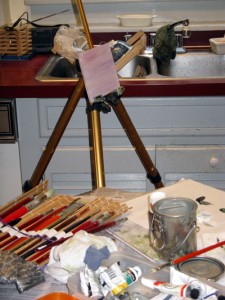
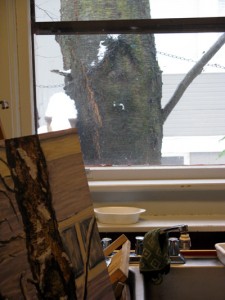




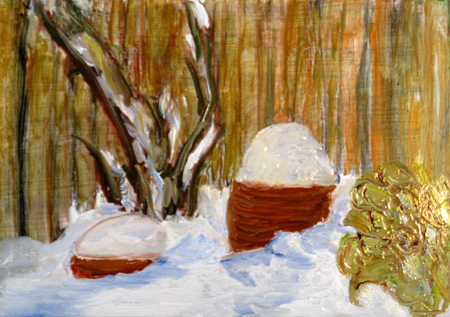
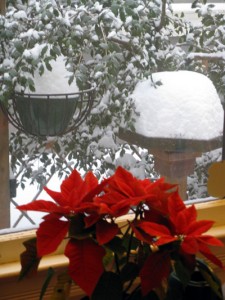
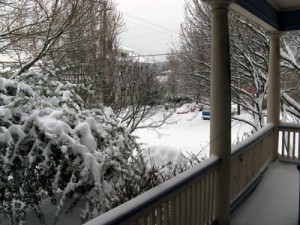
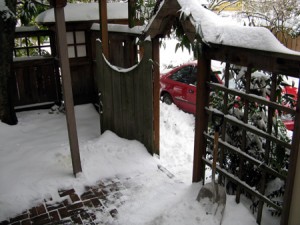

June
You bring up something that rearranged some pieces of my memory.
Adjacent to my home town was a housing project named Pineford Acres. This was put up around 1941 to provide housing for nearby Olmsted AFB. I discovered by chance that this project was designed by Louis Kahn. I frequented Pineford in my blithe youth to visit a friend and to take art lessons from a lady with cat litter problems. As I remember it, Pineford was totally unprepossessing but exotic to the extent that, at this time, I knew of no other planned community.
So it turns out that I spent time painting poorly in a modest Kahn living/dining room and wondered at Rosicrucian advertisements in my friend Richard’s Kahnish bedroom.
I dream often of separate and somewhat Brigadoonish neighborhoods that exist in the larger urban setting. It might be Louis Kahn’s parallel universe of housing that sowed the seeds in my young mind.
Well, yes, I am driven indoors by the weather where I lurk, brood and dream of warmer days. Perhaps now that the demands of the holidays have been largely met, I can venture so far as to pick up a tool.
I wish you a great thaw -snow being hard to paint, and a happy new year of well-executed work.
June,
About the sun and an old memory: My daughter migrated from room to room during the day to catch the sun shining into different rooms in our corner house in Michigan.
A still older memory: Spending many days looking out the window in Bethesda (immobilized while recovering from a sports injury), I watched squirrels in the trees around the house – happily copulating. They were cute!
About camera vision: Yesterday, I photographed a bright red ship here in Wilhelmshaven, Germany with the ‘Kaiser Wilhelm Bridge’ in the background. In the photograph, the bridge appeared much reduced in size. Contemplating perhaps painting the scene, I played with increasing the size of the bridge so that it properly ‘looms’ in the background.
This week, I attempted painting two water scenes from a photograph, using two different approaches, none very satisfactory. But the benefit is that I already understand a little bit better about streaming water.
Hi Jay and Birgit,
Jay, the thaw has arrived, but I haven’t gone out to paint yet; my painting buddy had a medical appointment and I finked out on going alone. But maybe tomorrow….. No more snow, just lots of rain and some occasional ice, falling from the sky.
Birgit, the sun shining through various windows, making each space unique yet ever-changing, is a true delight. I can generally tell the seasons of the year by the way the sun streams through certain windows in certain rooms. And we too have seen squirrels copulating in that very cherry tree that I painted. Hmmm, I missed an opportunity there. We were quite riveted by the sight of three of them, “cavorting” indiscriminately. But I neither photographed nor memorized what I saw; it would be out of character if I painted such scenes, which is why I’m tempted.
Birgit, I’m glad to hear you are painting and seeing how photographs differ from what you might paint. It’s a great exercise in both media. I have been doing water also and have discovered that a mixture of davy’s grey and ultramarine blue, with white as needed, makes a marvelous variety of shades for fresh water streams. My source said the color of the mix could imitate lapis lazuli. I don’t know about that, but I do know that it is a miraculous blend of color that works like nothing else I’ve found. At first I used it timidly, but I have gotten increasingly bold with it and the streams seem only to look better and better. It’s a transparent mixture, so using medium and no white, you can change the shades of the underneath hue, as in a glaze, without opaquing the scene. But some opaqueness sometimes works, too.
I’m thinking of looking at stylized Japanese water — you know, the kinds with the wonderful “S” shapes and trying to understand how they work as opposed to photographic depictions and painterly representations. I’ll let you know what I find out, if anything.
June:
I really like the tree in Cherry Tree With Pots. Your paint suggests and describes, both. As a side thought, have you ever rendered clapboarding with ruler straight lines? Just wondering how that would interact with the botany. References to Japanese work make me think of the fluidity that was achieved with crisp delineations.
Birgit:
Grand to hear that you continue painting. I look forward to the results.
Steve:
Whazzup?
Happy New Year to you all.
Jay,
An interesting idea – to contrast the organic tree with mechanical lines in the clapboard. I have never tried ruling lines this way, and my first reaction was negative (not unusual — being a contrarian, just a mild suggestion is enough to make me find tomes of arguments against….).
But thinking about it, adding ruled clapboard could make sense for a severe contrast and perhaps greater emphasis on the foreground pots and tree. The technical aspects are a bit daunting — I tend to go back and forth between parts of the painting, coming close to but not finishing anything until the very end. Marking off ruler-straight lines would then dictate that I must know where the edges are to be, which is something I tend to save tothe very end. As you can tell, I’m thinking about this. I have Cezanne’s word for ,my process — he saying that the painting should be worked all over all at once; but then I have my rational mind that tells me that as a metaphorical statement that might make sense, but in reality, it’s nonsense.
Thanks for the comment. Maybe I’ll play with photoshop and straighten out the lines and see what happens. As I imagine (rather than resist) more ruler-ed clapboard, I start to think that I might lose some of the nervous tension and jiggley dance of the lines next to the tree. It would be worth experimenting with (on the computer) to see if that is the case and if it would work. I think it might take away some of the wacky dance and I don’t know if that’s what I would want or not. I see I have a half-day’s work cut out for me.
June:
Blame Braque. His cubist paintings employ a linear scaffold that interacts with patches and color and value gradations. I can imagine his using a maul stick ( I believe that’s what the gadget is called), to gain a good line.
With George in mind I shrink from any suggestion of rulerishness with its concomitant implication of a dogged technique. My old friend Martin Linsey used to do watercolors with washes over a point-on-paper pencil drawing and the result was very free. He tried once to render a locomotive from a projected photo, using a straight edge in the process, and the result was bad.
June,
I will try your mix of davy’s grey and ultramarine blue for my water painting – with caution. Davy’s grey contains lamp black, toxic by skin contact.
Birgit,
Do you use a barrier cream when you paint with oils? I also have a box of surgical gloves that I resort to if I’m working in a particularly messy way. Working plein air is particularly messy, because of wind and weather. I didn’t know this about davy’s grey, which I often use for blocking in the image elements. I will use a different transparent dark in the future. Thank you.
Jay,
I’m responding to your idea of a “linear scaffolding.” My background in textiles and quilted art makes me understand the delight of the linear — not just the line, but the gridded line and spacings. So doing a gridded drawing and then painting over it feels like it has all kinds of potential.
I’m thinking that it would make people more comfortable (or responsive, perhaps) to my wonkier efforts — if I took out a support gridded with permanent ink and then did one of my cityscapes over it, people might have to linger more than 3 seconds. At least it would make clear that the wonkiness wasn’t just naive but rather intentional. It would hurt the eyes to look at, though. I might just have to try it.
Permanent ink (like Micron Archivals), comes through loud and clear even under opaque oil paint — you can’t overpaint it to oblivion — the only remedy is to hide it with more permanent ink. And I know this because I have at least once signed an abstract and then decided I liked it better turned upside down — only to discover that my signature was still clearly readable. All the lamp black in the world didn’t seem to obscure it.
And now I’m wondering what would happen if I painted over the viridian studies that I did — the formal versions, with the little squares of variations of greens and yellows and browns. Another gimmick, methinks, but fun to think of.
As it is January 2, I’m about to cut into pieces one long quilted landscape from John Day. It has been an irritant for months and today’s the day to get my revenge. Besides, the holidays are over and I can reclaim my textile (living room) studio.
June,
Is a barrier cream a special kind of skin cream or will any skin cream do?
I, too, contemplated using surgical gloves. So far, I have separated my paints into 3 categories – carcinogens, skin irritants and nontoxic.
Birgit,
Barrier Cream is a special cream made to block toxicity from paints. I use it whenever I’m painting — basically whenever I enter my studio, the first thing I do is smooth on some barrier cream, whether I’m gessoing with acrylic or painting with davy’s grey.
Here’s one example (Barrier Cream the brand name that I use, but there are others, I believe):
http://www.dickblick.com/zz004/91/
It’s a Winsor-Newton product that you can buy in jars (for the studio) or tubes (for plein air) I have both. And as I said I also use gloves, although they irritate me (emotionally and sometimes physically) so I limit their uses to messy matters — gessoing, for example, and if the wind is really wild outside. I even have long (mid-arm length) cleaning gloves for the times when I’m reaching down into my odorless mineral spirit containers to get the sludge out.
I try to be cautious but not paranoid about toxic materials. I’m always glad to have a bit of new info, such as you gave me about lamp black. But I’ll admit that I’m not as organized as you are about such things.
June,
Thanks for telling me about the barrier cream.
Organizing chemicals with respect to their potential hazards is a habit of mine that is formed by obligatory yearly refresher courses in chemical safety together with routine inspections of laboratory environments to enforce chemical safety procedures.
Birgit,
Do you have an easily accessible reference for various pigments, etc? I could use one.
June,
So far, I have only read what dickblick.com says about the pigments under pigment information. For example, http://www.dickblick.com/items/00461-5423/#PG7
What draws and repels you to make art at this season, in your space, in your time?
We’ve had fabulous new snow here for a couple weeks, which is immensely inspirational. Actually cameras, as well as paints, can have weather problems, particularly batteries that don’t work in the cold. But the main obstacle is the “in your time” part–it’s been completely lacking. Yet I am confident I’ll get out sooner or later…